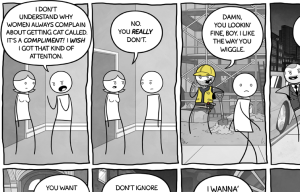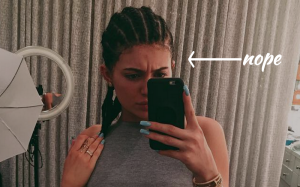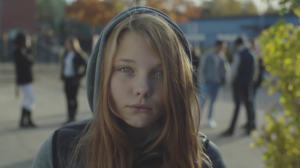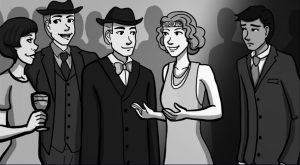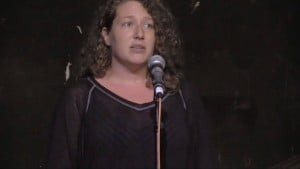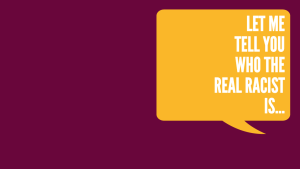Have you noticed how white male privilege shapes our US educational system? For someone like me – Black, girl, and nerd – it’s hard to miss.
I got an early start in being a nerd. From the time I was three years old, even before kindergarten began, I was thrilled about the idea of going to school.
My parents stressed the importance of education as the key to success, and I was eager to build my knowledge.
But then, white male privilege got in the way.
There’s a fourth grade assignment that sticks with me. I remember it well because I couldn’t complete it and – being the nerd that I was – I felt like a failure.
The assignment was a family tree. Like many Black Americans, records of my ancestry have been erased through slavery, Jim Crow, and other horrible acts of white supremacy, so my family tree had bare branches.
Now I know I wasn’t a failure – though my teacher’s lack of racial justice, cultural awareness, and general forethought was absolutely a major failure – but that moment of exclusion was a hard realization for eight-year-old me.
My only regret is that I wasn’t as bold as the irritated Black sixth grader who recently filled out a worksheet with honest answers about her family’s origins.
These assignments aren’t created with students like us in mind, one of many failures of an educational system that lets children of color down every day.
I’ve never completely lost my love for school. But I have had my heart broken by the reality that the US educational system doesn’t have love for me.
Though I didn’t learn about terms like “white supremacy” or “patriarchy” until much later, these systems were already affecting my life.
The family tree assignment, like so many others, assumes that everyone has the same experience – one that doesn’t include having your heritage ripped apart by colonization, slavery, imperialism, and other oppressive forces.
It doesn’t recognize that some students have white US privilege – which gives them a quality of education that other students can’t access.
This plays out in lots of other ways in the academic system.
For instance, a video of a police officer physically attacking a Black girl at Spring Valley High recently went viral as part of a nation-wide conversation about how often violence and criminalization targets students of color. It’s outrageous that these students have to carry trauma and fear in order to get an education.
Because many people try to avoid conversations that work to address and disrupt white male privilege, it feels critical to enter this conversation with pointing out that discussing privilege in school isn’t about demonizing teachers or white male children.
Privilege works as a system, and that system shows up throughout our lives, including in childhood. People can participate without even meaning to.
It’s important to look at everything that creates and upholds these systems in our K-12 schools – from textbooks to school administration to the everyday, often invisible ways we follow society’s expectations of race and gender.
Addressing bias in our places of learning can create a huge shift toward equality in the future youth are helping create, and teaching children to think critically and interrogate systems that aren’t working should be a goal of education.
We need to challenge the educational system itself when it’s letting down students who are children of color, girls, and/or gender nonconforming.
Here’s how white cisgender male students get the benefits of systems of oppression more than anyone else in elementary and high schools.
1. White Students Are More Likely to Go to Schools with More Resources
The quality of education that students get often depends on the amount of funding their school has.
School districts in low-income neighborhoods get less funding. These are also the areas where more children of color are likely to live – Black, Latinx, and Native children are more than twice as likely to live in poverty than white children.
The racial disparity in school funding goes even deeper than an overlap with poverty.
In Pennsylvania, for instance, districts with a higher proportion of white students get much more funding “at any given poverty level.”
Growing up poor hurts cognitive ability and emotional processing, and increases the chances of mental health issues. On top of these challenges, school districts with more students of color have fewer resources to provide an education that can help students break out of the cycle of poverty.
2. Most of the Literature Taught in School Is Written by White Male Authors
I’ve always dreamed of writing, and my dream has come true – I’m a writer now. But as a child, it took me a long time to realize that I could even be a writer, simply because I was a Black girl.
It seems silly, I know. There are lots of women writers and writers of color alive now and throughout history.
However, in elementary and high school, I read books from the Western literary canon – which mostly consists of white men.
For me, this wasn’t an impossible barrier to overcome. But this preference for writing by white men did more than threaten my dreams. It also limited the perspective that I learned from.
What our society considers neutral writing, objective writing, even the best writing, is written primarily by one demographic.
By excluding books from marginalized communities, we’re teaching children that writing well means writing like a white man.
It took finding the books my teacher didn’t assign to learn that there are many, many more literary traditions from all around the world.
3. Students Are Taught Only Western Culture’s Approach to Math and Science
Students learn that the approach they learn in school is the “right” way to do things. When it comes to subjects like math and science, many of us accept what we learn in school as the objective way to get the right answers.
But it’s not the only way.
Many non-Western cultures have other approaches, and some Western concepts of math and science come from other cultures that go unrecognized.
Some students suffer when their lessons favor Western ways as the only way.
For example, by the time Native students begin formal schooling, many of them already have scientific knowledge from indigenous traditions. When their school curriculum ignores this knowledge and Native learning strategies, many of these students struggle.
Native students have the highest drop-out rate of any ethnic group. According to research, they would benefit greatly from education that centered their needs, instead of requiring them to disconnect from their culture.
4. White Students Can Experiment Without Being Criminalized Based on Race
Creativity and exploration are important parts of the learning process for children. Some of the most innovative and successful adults started out as children with the freedom to experiment (think Steve Jobs).
So it’s unfortunate that students of color who experiment can be racially profiled and treated like criminals just for doing so.
Fourteen-year-old Ahmed Mohamed, a Sudanese Muslim teenager, built a clock at home. When he brought it to school to show his teacher, he was arrested and accused of bringing a bomb.
Before him, Keira Wilmot, a Black teenager, conducted an experiment with two household chemicals in a bottle. The chemicals caused the top of the bottle to pop off and created smoke. Kiera was also arrested, expelled, and charged with two felonies.
Both of these cases got coverage in the media, and public pressure helped lead authorities to drop the charges against them. But they’re just two examples of many children of color who are routinely criminalized in school, making creativity a risk.
5. White Male Students Aren’t Told That STEM Fields Aren’t for Them
It’s no coincidence that Science, Technology, Engineering, and Math fields are largely dominated by white men.
Spend time in an elementary or high school classroom, and you might witness lots of ways white girls and children of color of all genders are treated like they’re not capable in STEM subjects.
A study of physics doctorates over 39 years showed that 22,172 degrees went to white men – and 66 to Black women.
Many of those women started out as girls who were discouraged from participating in STEM.
They beat the odds against them, but this clearly has a big impact on many children from their demographic.
6. Native English Speakers Can Speak Their Native Language in School
In the United States, there are over 300 languages spoken as a first language, with more than 60 million people speaking a language other than English at home.
While schools are required to have ESL classes for students learning English, these students are left behind with materials and standardized tests all given in English.
The US has no official language – but we often treat American Standard English as if everyone should speak it.
But it’s not just a matter of students needing to learn English. Some students are even criminalized for speaking their native language.
For instance, students have been suspended for speaking indigenous languages. This oppressive practice is even more terrifying when you realize where it comes from.
In the late 1800s, the US government began forcing Native children to attend boarding schools designed to assimilate into white culture. The experience was horrifying, and it’s supposedly over – but those awful practices still show up with rules banning things like indigenous languages.
These rules continue to force marginalized students to assimilate or face punishment.
7. Anglicized Names Aren’t Mocked and Othered
Brad, David, Timothy – call out these names on a classroom roster, and you’ll probably just have a kid call out “here.”
But call out a name that’s not Western European or Anglicized, and at many schools, people – including teachers – will laugh.
As a result, many students of color end up taking on nicknames or having them bestowed on them. Or they have to put up with other people mispronouncing or making fun of their names.
It’s one of many ways white US culture is normalized in schools, while everyone else’s culture is othered. Students of color can end up internalizing racism and xenophobia against their culture, and feeling like they’re inferior because of their heritage.
8. White Male Students Aren’t Ostracized, Bullied, or Punished for Their Style of Dress
“Distracting.” “Gang-affiliated.” “A fad.”
These terms are often used to ban certain styles, clothing, and other forms of expression in schools.
And sure, it sounds like anything fitting those descriptions would interfere with students’ academic focus, so banning these things might seem justified.
But what about when school administrators use these terms to describe the culturally specific ways children of color dress and express themselves?
For instance, Black children with afros and cornrows and Native children with traditional braids and mohawks have all been punished for their hairstyles. Some have also been bullied by other children who picked up on the “othering” of their hair.
These children are basically being told that they have to be more like their white peers, or they’ll be ostracized, or even treated like they’re a threat to those around them.
Girls also get treated with a double standard when it comes to dress codes – they often get the message that it’s up to them to cover up, or they’re to blame for objectification and sexual violence. Many students are now protesting sexist dress codes.
Because all children – not just the white boys – should be able to get dressed for school without the pressure of worrying that their appearance is judged as a “distraction.”
9. White Students Can Have Outbursts and Be Labeled ‘Rowdy’ – Not ‘Dangerous’
Of course, many school rules are in place for a reason. If you’ve been in a classroom, you know that requirements like staying seated or waiting your turn to speak can help maintain order that’s helpful for learning.
But after being around a group of children, you’ll also know that these rules are not always followed. Children’s minds are still growing, so they’re still learning about the consequences of their actions.
Some kids have a hard time sitting still. Some kids have outbursts when they get excited or upset. Some kids break the rules. This is a natural part of childhood.
Society accepts that this is true for white children, and even expect troublemaking from boys with common phrases like “boys will be boys.”
But children of color are often treated like criminals for the same behavior that’s considered normal for white students – they get harsher punishments, and are more likely to get suspended or expelled.
And even the youngest students of color are more likely to have the police called on them, to be arrested, and to be put into the traumatizing school-to-prison pipeline that incarcerates them at a young age and never lets them go from the racist criminal justice system.
10. Boys Are More Likely to Be Called on When They Raise Their Hands
Teachers are more likely to call on boys than girls when they raise their hands, and they’re also more likely to listen when boys call out answers without being called on.
When girls do the same, teachers are more likely to remind them to follow the rules and raise their hand.
That means boys get to participate more in class, and they gain confidence in their abilities with positive reinforcement for giving answers.
In addition to calling on the boys, teachers are more likely to give them other “esteem building” attention, like more constructive feedback and compliments on achievements instead of appearance.
More interaction, attention, and encouragement means boys get more positive engagement in class. They get more direct support and can build more confidence.
Girls get lower quality and quantity of attention, resulting in lower self-esteem and achievement. When teachers expect more from boys – especially white boys – the discouragement of other students shows.
11. White Male Students Are More Likely to Get Treatment for Neurodivergence
Many of the obstacles listed here also affect children with disabilities, mental health problems, and neurodivergence. But among students who would benefit from diagnosis and treatment, students who are girls and/or children of color are often overlooked.
For instance, 80% of people diagnosed on the autism spectrum in the US are male. Studies suggest that girls must exhibit more severe symptoms to be diagnosed – and more subtle symptoms might be dismissed because of society’s expectations of girls’ behavior.
In another example, Black children are less likely than white children to be diagnosed with ADHD, and those diagnosed are less likely to get treatment. For some, expectations of low achievement lead professionals to dismiss their symptoms.
Others follow the common trend of criminalizing Black and Latinx youth and seeing their symptoms as “problem” behavior.
It’s telling that society is so quick to discuss the mental health of white male school shooters. We’re used to evaluating white boys’ mental wellness, but blaming other children for the disruptive symptoms of their own health problems.
12. White Students Aren’t Learning Romanticized Versions of Terrible Things That Happened to Their Ancestors
There’s a saying that “history is written by the victors.” So when you’re taught a version of history describing your ancestors as the victors, learning can be pretty sweet.
That’s not the case for students of color.
They have to sit through lessons that show their ancestors being killed, colonized, and enslaved – and then applaud the attackers as heroes.
Elementary school textbooks show outrageous examples of this: Christopher Columbus – who’s responsible for raping, displacing, and killing so many Native people – hailed as a great discoverer who befriended and helped Indigenous people.
African people who were violently kidnapped, chained, and enslaved described as “workers” who immigrated to this land.
History books gloss over the racism and sexism in the US Constitution to tell a glorious version of how the Founding Fathers brought our country into being.
If we’re teaching our children that America is the great “land of the free,” shouldn’t students learn what it takes for oppressed people to fight for their freedom in this country? We need to rethink what we’re teaching our children about what it means to be a hero.
13. White Students Don’t Have Their Culture Objectified
Another perk of being a white student is that people like you – especially men – are presented as human beings.
It doesn’t seem like much to ask, but it’s more than Native students, for instance, can expect. Many can attest to having Indigenous people portrayed as relics of the past.
It’s not uncommon to have school children participate in activities like “dressing up like Indians” around Thanksgiving time.
This activity may not have sinister intentions, but it’s one of the many ways we’re taught that “appreciating” other cultures means dehumanizing the people of that culture.
Imagine if a teacher said, “Let’s dress up as white people for a day!” It’s an absurd idea, because we’re used to whiteness being normalized in school. Learning about white people’s accomplishments is what we in the US tend to call learning about “history.”
But learning about Native history requires a special unit that romanticizes the horrific genocide against their people. Black history looks like incomplete stories told in February about Dr. Martin Luther King, Jr. and Rosa Parks. Latinx, Asian, and Pacific Islander students are lucky if they learn anything about their history at all.
Being invisible or objectified is not enough to learn about your history. When schools don’t recognize this bias, they present whitewashed versions of history as if that’s all there is to know – missing vital opportunities to show students of color that they can be heroes, too.
***
I could go on – this is really only the beginning of all the ways our schools center students who are white, cisgender boys.
My hope is that reading these examples can help you start to recognize when privilege shows up for some students and hurts those without it.
And I don’t know about you, but after going through all of this disheartening information, I’m ready for a change in our educational system.
Not to demonize white male children or to say that they don’t earn their success – but to give all children a chance at the same achievements.
All of our children deserve support, encouragement, and empowerment – their racial or gender identity shouldn’t take away from that.
I’ve got some ideas for how you can help. If you’re a teacher, you can work on recognizing and unlearning your own biases, so you don’t inadvertently bring racism or sexism into your classroom.
If you’re a parent, you can pay attention to your child’s assignments and demand better when they’re learning oppressive lies.
No matter who you are, you’re probably familiar with these common ways of defaulting to the status quo that favors white males.
That doesn’t mean you’re a bad person – it means you have the power to help change these oppressive habits in your life and with the people around you.
Consider the impact that white male domination is having on our children. All of them – including the white boys who are put into narrow boxes of society’s expectations – are getting a raw deal as long as sexism and white supremacy have a strong hold on education.
For our children’s healing and well-being, let’s help them build a better world.
[do_widget id=’text-101′]
Maisha Z. Johnson is the Digital Content Associate and Staff Writer of Everyday Feminism. She is also an apprentice editor with Black Girl Dangerous and a blogger for Pyragraph, and she facilitates empowerment groups with incarcerated women as part of Fired Up!, a program of California Coalition for Women Prisoners. Through her own project, Inkblot Arts, Maisha taps into the creative arts and digital media to amplify the voices of those often silenced. Read her blog or follow her on Twitter @mzjwords.
Search our 3000+ articles!
Read our articles about:
Our online racial justice training
Used by hundreds of universities, non-profits, and businesses.
Click to learn more







